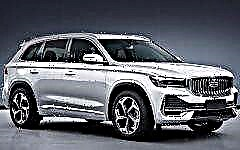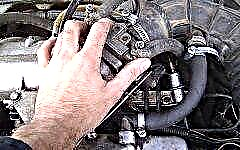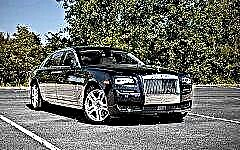The automatic parking system has already found its fans, but the autonomous one is just beginning to search. Let's talk about the principle of work, the types of the system and what it consists of.

The content of the article:
- Automatic parking system
- Components
- Looking for a parking place
- Parking process
- Difference of systems
- Components of an autonomous system
- Principle of operation
Speaking of the fact that the car can park on its own, now you will not surprise anyone. It is commonly known as automatic car parking. Progress does not stand still, and BMW has stepped forward faster than anyone by offering the Remote Valet Parking Assistant autonomous parking system. In another way, it is a remote parking assistant.
But these progressive systems are based on older, working patterns. In this case, it is an automatic parking system, which is now found on many modern cars, even not new ones.
Automatic car parking system

This auxiliary system is referred to as active safety systems. The main purpose is the automatic parking of the car with the participation of the driver.
This is not to say that the system exists in one form. This system can be used for parallel or perpendicular parking. Systems with parallel parking are more common. Parking is based on the speed of the vehicle and the angle of rotation of the wheel.
Different companies call the system differently:
- Volkswagen - Park Assist, PAV;
- Lexus or Toyota - IPAS;
- Opel - Advanced Park Assist;
- Ford or Mercedes-Benz - APA;
- BMW - RPA System.
Parking system mechanisms

The main components are ultrasonic sensors, followed by switches, an electronic control unit and other executive devices of the machine.
It is worth considering that without additional systems, automatic parking will not be able to work. So, for example, this is a power steering, an on-board computer in some models should only have an automatic transmission.
Ultrasonic sensors in the system are similar to the passive parking system, but differ in a longer range, this is about 4.5 m. Depending on the manufacturer of the system and the car brand, the number of sensors may differ. Typically 12 ultrasonic sensors are installed, 4 on the side of the vehicle, four in front and four behind the vehicle.
The system is activated forcibly by turning on a button on the instrument panel or steering wheel when the driver plans to park. When the system is activated, the electronic unit begins to receive a signal from the ultrasonic sensors, converting them into control functions for actuators. Such devices include engine control, electric power steering, automatic or manual transmission and stability control system.
Depending on the manufacturer, the information can be displayed on the display as auxiliary for the driver and at the same time drive the car in automatic mode, if the driver has given permission to do so.
The principle of finding a parking space

As it is already becoming clear, the search for a suitable parking space is carried out using ultrasound sensors. On the sides, as expected, there are 4 such sensors, two on each side, in front and behind. While the car is moving, between the rows of parked cars, at a speed of up to 20 km / h for transverse parking. Up to 40 km / h for parallel parking, sensors scan the distance between cars and their position relative to your car. The control unit processes incoming signals from the sensors, if the distance is suitable for parking, the system will give the driver an appropriate signal and display relevant information on the screen. As a rule, the system will take as a basis a distance that is 0.8 or 1 m longer than the length of the entire vehicle.
Automatic car parking

This parking process can be divided into two types:
- with the help of instructions under the control of the driver;
- automatic parking without driver participation.
In the first method, prompts, visual and test instructions will be displayed to the driver on the information display. Based on the prompts and the trajectory, the driver decides how best to park. Most often, these are recommendations for the steering wheel, which steering angle is better to choose and the direction of travel. Typically this is configured for Advanced Park Assist.
The second method is different, in comparison with the previous one, the driver does not participate in the parking process, and all functions are performed automatically. Instead of the driver, the steering wheel will turn on its own in the desired direction, just like pressing the gas pedal. One thing a driver may need is to shift the gearbox to move forward or backward.
For safety reasons, the automatic parking system can be switched to manual parking at any time.
Autonomous or automatic parking system

Progress is underway, and the vehicle's auxiliary systems are also progressing. As mentioned above, the automatic system can work when the driver is sitting and watching the process of parking the car. An innovation was the autonomous parking system, when the driver can be outside the car, while grabbing the ignition key and turning on the autonomous parking function.
At the moment, several companies are working on the system, each in its own direction, these are Volkswagen and Bosch, BMW and Continental. According to BMW representatives, they want to implement it in production cars starting in 2016.
Components of an autonomous parking system

The autonomous car parking system consists of an electronic control unit, input devices and command execution devices. The devices for reading or input include laser sensors (lidars), as well as a remote control. As a rule, in an autonomous parking system, four laser sensors are installed around the entire perimeter of the car. Thanks to their accuracy, the system works much better, and also perfectly scans obstacles.
It is based on an automatic car parking system and collision warning around the entire perimeter of the car. Thanks to such components and technologies, time is significantly saved; the system has shown itself best of all in multi-storey parking lots. The system can also place the car in a space of 20 cm on each side of the car, which is very space saving.
How an autonomous system works

Activation of the autonomous car parking system begins with pressing a button on the remote control. The remote control is designed as a Smart Watch, and not, as is customary, in the form of a keychain. Volkswagen took a step further and decided to use the driver's smartphone as a remote control. The most important difference between such a system from the previous generation or, in a different way, from the base is self-parking without the participation of a driver. Also, the car can independently move to the place of embarkation of the driver and passengers.
How does such a marvelous system work? Lidars, having removed the data, send them to the electronic control unit. The program, sewn into the block, passes the information received through an algorithm to assess the situation, obstacles, adjust the speed, navigate and find a place minibus.
Thanks to the use of many systems of the car, the control unit itself can decide how much to accelerate or pause the car.One drawback is that a digital map (plan) of the parking building is stitched into the block, while the system does not use GPS maps and signals. Most often this is done for closed parking lots, where the signal simply cannot pass. But there is nothing to flash for open parking lots.

As a result, the electronic control unit generates signals for control systems, which are then transmitted to these vehicle systems: engine control, transmission, steering wheel and others.
A huge advantage of the system is that it does not cost a lot of money, and orientation in the parking lot does not take much time. Also, the driver is not obliged to sit and watch the car until the last, until the car stops. As a result, many manufacturers will install autonomous parking systems on new production vehicles instead of automatic parking.











